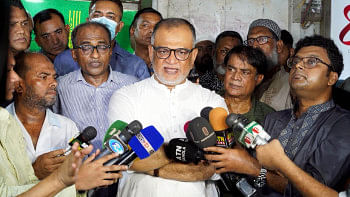Hybrid rice to feed rising population: analysts
The cultivation area of hybrid rice—which offers higher yield than conventional inbred varieties—did not see a significant change since 1998-99 when the government granted permission for its farming.
Hybrid rice cultivation area has remained unchanged at 8 lakh hectares for the last few years and it is yet to cross the 10-lakh-hectare mark, the highest recorded in 2009-10.
So far 174 varieties of hybrid seeds were released but nearly 30 of them survived in the market due to farmers' unwillingness to use the seeds, which they think may fail in producing expected yield, analysts said yesterday.
More cultivation of hybrid rice can help the country to avert its future challenge of diminishing trend of cultivable land, they said at a dialogue on “Hybrid rice -- harnessing untapped potential”.
Bangladesh Rice Foundation (BRF) and Bangladesh Seed Association (BSA) jointly organised the dialogue at the Bangladesh Agriculture Research Council's conference room in Dhaka.
Poor quality seeds, inadequate research to invent good variety of seed and lack of awareness campaign among the farmers are the core challenges to making hybrid rice popular, according to them.
Crop lands amounting to 62,000 hectors decrease per annum because of the spiralling population, which leave a negative impact on agricultural production, said Md Nasiruzzaman, secretary-in-charge of the agriculture ministry.
Climate change, rapid expansion of salinity into new arable land and frequency of natural disasters in recent years have also impeded the increase of rice production, he said while addressing the event as the chief guest.
The country has to produce an additional 20 lakh tonnes every year against the annual average rice production of 348 lakh tonnes with a view to attaining self-sufficiency in yield of the staple crop, he said.
Production of hybrid rice in more farm lands will give us a solution stemming from the challenges as its yield is 15-20 percent higher than the inbred varieties, Nasiruzzaman said.
He suggested the seed producers utilise the southern part of the country where coarse variety of rice was popular among the inhabitants.
Farmers usually believe that they might not get their desirable production if they cultivate the hybrid rice, said M Anis Ud Dowla, president of Bangladesh Seed Association.
“The private sector has a vital role in popularising the crop. And the government also should take initiative to find a way out on how to cater the seed of hybrid rice to the farmers,” said Anis, also chairman of ACI Group.
The highest priority should be given to establishing a hybrid rice research institute to address the challenges of amylase and abiotic and biotic stresses, said Md Shahjahan Kabir, director general of Bangladesh Rice Research Institute (BRRI).
“Hybrid rice seed production is highly technical, so required support needs to be extended at the farmer level who is interested to engage in seed production process,” he said.
Mohammed Masum, chairman of Supreme Seed Company, and Jamil Hasan, head of hybrid rice division at the BRRI, presented two separate keynote papers at the dialogue.
The authorities concerned should provide enough funds, human resources, training and logistic support to all stakeholders to help hybrid rice to flourish, Masum said.
Mentioning data of the Department of Agricultural Extension, he said the cultivation of hybrid rice accounted for only 7.13 percent of the total 1.14 crore hector lands in 2016-17.
Hybrid rice seed industry should be declared a thrust sector in the financial policy of Bangladesh Bank, Hasan said while presenting his paper.
Among others, Z Karim, former chairman of Bangladesh Agriculture Research Council; AM Muazzam Husain, chairman of the BRF, and Sayed AB Siddiqui, executive director, also spoke at the event.

 For all latest news, follow The Daily Star's Google News channel.
For all latest news, follow The Daily Star's Google News channel. 



Comments